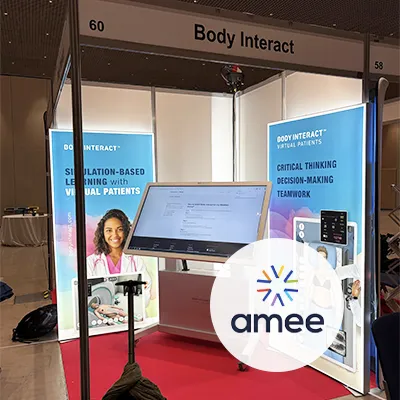Beyond Mannequins
How Virtual Patients are Transforming Healthcare Simulation and Training
Healthcare education has seen a revolution over the past few decades with simulation technologies becoming central to teaching and training in medical and nursing curricula. Traditionally, resources like mannequins and human patient simulators dominated simulation-based learning, offering realistic, hands-on practice. With the rise of Virtual resources and tools, the landscape has evolved further, and literature reflects this.
In this post, we’ll explore the different types of simulation resources and focus on why virtual patients offer a more engaging, flexible, and transformative learning experience.
Traditional Simulation Resources in Healthcare Curricula
Simulation technologies and resources in healthcare-based education typically fall into two categories, based on their degrees of fidelity.
[Fidelity: a term used to describe how closely the simulation replicates real-life clinical settings and experiences]
Low Fidelity: This may involve basic tools like mannequins, standardized patients, or simple task trainers to practice isolated skills such as suturing or taking vital signs.
Strengths: These are cost-effective and ideal for foundational learning.
High-fidelity simulations: Uses advanced equipment such as computer-based simulators, life-like mannequins with physiological responses, or immersive virtual reality environments.
Strengths: These resources, globally, are particularly valuable for teaching complex clinical reasoning, teamwork, and crisis management in scenarios that mimic high-stakes, real-life emergencies.
Enter Virtual Patients: A New Era of Simulation
Body Interact Virtual Patients are interactive, computer-based representations of real-life patients, or as some may call them Virtual Mannequins, designed to simulate clinical encounters in a realistic yet virtual environment. Unlike mannequins or Virtual Reality alone, Virtual Patients incorporate both clinical reasoning and interpersonal skills in a dynamic way.
What Makes Body Interact Virtual Patients Unique?
Body Interact combines:
Realistic Clinical Scenarios
Learners interact with simulated patients who respond dynamically to questions, interventions, and decisions, in different clinical (consultation, emergency room, and ambulance) and non-clinical (home and street) settings.
Physiologic Algorithm
Learners will engage in interactive storytelling where clinical cases evolve based on their actions, encouraging active problem-solving.
Accessible
Body Interact can be accessed online on laptops, tablets, or even smartphones.
Flexible Learning Pace
Learners can progress at their own pace, revisit cases, and repeat scenarios as needed, making it suitable for self-directed and asynchronous learning.

What sets Body Interact apart?
Cognitive Engagement
Unlike mannequins or VR models that primarily focus on procedural training, Body Interact virtual patients simulate a holistic scenario where learners practice communication, physical examination, and decision-making.
Cost-Effective and Scalable
Virtual patients require no expensive hardware or maintenance, unlike high-fidelity mannequins. They can be deployed across multiple learners simultaneously, providing standardized yet personalized experiences.
Safe Space for Repeated Practice
Learners can make mistakes, explore alternative treatment paths, and receive immediate feedback without the fear of harming real patients or damaging equipment.
Versatility Across Specialties
In Body Interact extensive library users will encounter a wide range of medical conditions, from chronic diseases to acute emergencies, catering to all levels of learners.
Adaptable Curricular Integration
Due to its features, Body Interact Virtual Patients have proven to effortlessly integrate different methodologies (such as Problem-Based Learning or Flipped Learning) and complement learning experiences with other simulation resources, in a Hybrid Simulation approach.

Impact: Integrating Virtual Patients into Curricula
The implementation of virtual patients in medical and nursing curricula has shown effective benefits, including:
Enhanced Reasoning Skills – Critical Thinking, Clinical Reasoning, and Problem-Solving
Learners must analyze information, prioritize actions, and make evidence-based decisions.
Promote Non-Technical Skills development
Learners confidence and anxiety regarding decision-making.
Consistent Learning Outcomes
Virtual patients deliver standardized responses, ensuring consistent training quality for all learners.
Remote and Flexible Learning
Especially relevant in today’s hybrid learning environments, virtual patients support distance education seamlessly.
Moving Beyond Mannequins
The Future of Simulation-Based Learning
Body Interact Virtual Patients represent the next leap forward in terms of Simulation-Based Learning. Their ability to bridge clinical knowledge, communication, and problem-solving in an accessible, interactive format makes it a vital resource for future healthcare professionals.
By integrating virtual patients into medical and nursing curricula, educators can prepare learners for complex, real-world scenarios in ways that were previously unimaginable. They go beyond mannequins by offering scalable, flexible, and holistic simulations that truly transform healthcare training.
Conclusion
Virtual patients are not just another simulation tool: they are a game-changer in healthcare education. By combining cognitive and clinical training, Body Interact addresses the gaps left by traditional resources like mannequins and VR simulations. As technology continues to advance, the use of virtual patients will only expand, creating smarter, more prepared, and more empathetic healthcare providers.
Healthcare simulation is no longer limited to physical spaces or static mannequins. With virtual patients, we are paving the way in a new era of flexible, engaging, and comprehensive learning.
Ready to explore more?
Check the webinar recently conducted on this matter. Contact our Body Interact team
If you’re passionate about transforming healthcare education, consider integrating virtual patients into your training programs today. Request a meeting









